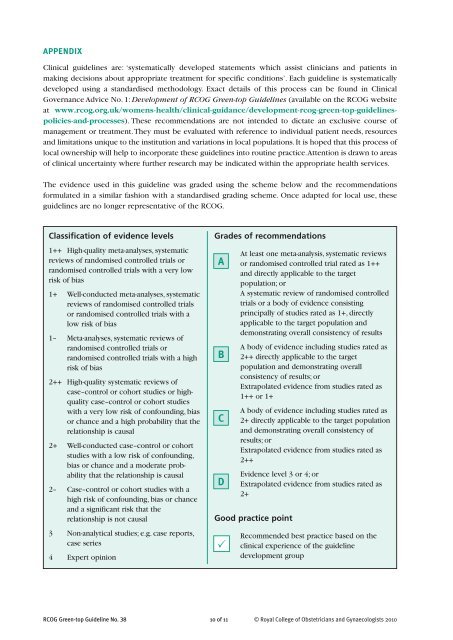The Management of Gestational Trophoblastic Disease - Green-top 38
The Management of Gestational Trophoblastic Disease - Green-top 38
The Management of Gestational Trophoblastic Disease - Green-top 38
You also want an ePaper? Increase the reach of your titles
YUMPU automatically turns print PDFs into web optimized ePapers that Google loves.
APPENDIX<br />
Clinical guidelines are: ‘systematically developed statements which assist clinicians and patients in<br />
making decisions about appropriate treatment for specific conditions’. Each guideline is systematically<br />
developed using a standardised methodology. Exact details <strong>of</strong> this process can be found in Clinical<br />
Governance Advice No. 1: Development <strong>of</strong> RCOG <strong>Green</strong>-<strong>top</strong> Guidelines (available on the RCOG website<br />
at www.rcog.org.uk/womens-health/clinical-guidance/development-rcog-green-<strong>top</strong>-guidelinespolicies-and-processes).<br />
<strong>The</strong>se recommendations are not intended to dictate an exclusive course <strong>of</strong><br />
management or treatment. <strong>The</strong>y must be evaluated with reference to individual patient needs, resources<br />
and limitations unique to the institution and variations in local populations. It is hoped that this process <strong>of</strong><br />
local ownership will help to incorporate these guidelines into routine practice. Attention is drawn to areas<br />
<strong>of</strong> clinical uncertainty where further research may be indicated within the appropriate health services.<br />
<strong>The</strong> evidence used in this guideline was graded using the scheme below and the recommendations<br />
formulated in a similar fashion with a standardised grading scheme. Once adapted for local use, these<br />
guidelines are no longer representative <strong>of</strong> the RCOG.<br />
Classification <strong>of</strong> evidence levels<br />
1++ High-quality meta-analyses, systematic<br />
reviews <strong>of</strong> randomised controlled trials or<br />
randomised controlled trials with a very low<br />
risk <strong>of</strong> bias<br />
1+ Well-conducted meta-analyses, systematic<br />
reviews <strong>of</strong> randomised controlled trials<br />
or randomised controlled trials with a<br />
low risk <strong>of</strong> bias<br />
1– Meta-analyses, systematic reviews <strong>of</strong><br />
randomised controlled trials or<br />
randomised controlled trials with a high<br />
risk <strong>of</strong> bias<br />
2++ High-quality systematic reviews <strong>of</strong><br />
case–control or cohort studies or highquality<br />
case–control or cohort studies<br />
with a very low risk <strong>of</strong> confounding, bias<br />
or chance and a high probability that the<br />
relationship is causal<br />
2+ Well-conducted case–control or cohort<br />
studies with a low risk <strong>of</strong> confounding,<br />
bias or chance and a moderate probability<br />
that the relationship is causal<br />
2– Case–control or cohort studies with a<br />
high risk <strong>of</strong> confounding, bias or chance<br />
and a significant risk that the<br />
relationship is not causal<br />
3 Non-analytical studies; e.g. case reports,<br />
case series<br />
4 Expert opinion<br />
Grades <strong>of</strong> recommendations<br />
A<br />
B<br />
C<br />
D<br />
At least one meta-analysis, systematic reviews<br />
or randomised controlled trial rated as 1++<br />
and directly applicable to the target<br />
population; or<br />
A systematic review <strong>of</strong> randomised controlled<br />
trials or a body <strong>of</strong> evidence consisting<br />
principally <strong>of</strong> studies rated as 1+, directly<br />
applicable to the target population and<br />
demonstrating overall consistency <strong>of</strong> results<br />
A body <strong>of</strong> evidence including studies rated as<br />
2++ directly applicable to the target<br />
population and demonstrating overall<br />
consistency <strong>of</strong> results; or<br />
Extrapolated evidence from studies rated as<br />
1++ or 1+<br />
A body <strong>of</strong> evidence including studies rated as<br />
2+ directly applicable to the target population<br />
and demonstrating overall consistency <strong>of</strong><br />
results; or<br />
Extrapolated evidence from studies rated as<br />
2++<br />
Evidence level 3 or 4; or<br />
Extrapolated evidence from studies rated as<br />
2+<br />
Good practice point<br />
P<br />
Recommended best practice based on the<br />
clinical experience <strong>of</strong> the guideline<br />
development group<br />
RCOG <strong>Green</strong>-<strong>top</strong> Guideline No. <strong>38</strong> 10 <strong>of</strong> 11 © Royal College <strong>of</strong> Obstetricians and Gynaecologists 2010
















